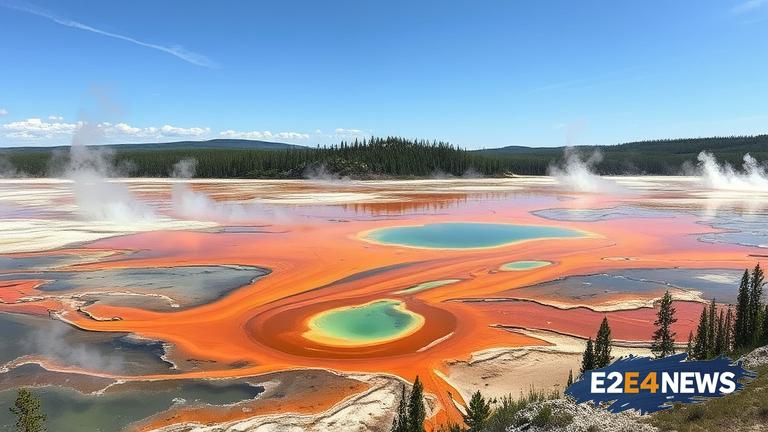Yellowstone National Park, located in the western United States, is a treasure trove of geological wonders. The park’s unique geology is characterized by an abundance of hydrothermal features, including hot springs, geysers, and fumaroles. These features are a result of the park’s location over a volcanic hotspot, where magma from deep beneath the Earth’s surface heats up groundwater, producing the steam and hot water that drive these hydrothermal systems. The most famous of these features is Old Faithful, a geyser that erupts regularly, shooting steam and water high into the air. However, these hydrothermal features also pose a significant hazard to visitors and the surrounding environment. The park’s geology is dynamic, with new features forming and old ones disappearing over time. This constant change can lead to the creation of new hazards, such as the formation of new hot springs or the collapse of ground surfaces. In addition, the park’s hydrothermal system is closely tied to the regional volcanic system, which has produced three massive volcanic eruptions in the past 2.1 million years. These eruptions have had a profound impact on the surrounding environment, producing widespread ash fall and pyroclastic flows that have shaped the park’s landscape. Despite these hazards, Yellowstone remains a popular destination for tourists and scientists alike, offering a unique glimpse into the Earth’s geological processes. The park’s hydrothermal features are not only beautiful but also provide valuable insights into the Earth’s internal workings. By studying these features, scientists can gain a better understanding of the park’s geological system and the hazards it poses. This knowledge can be used to inform management decisions and mitigate the risks associated with these hazards. For example, the park’s geologists closely monitor the activity of the hydrothermal features, tracking changes in temperature, gas emissions, and ground deformation. This monitoring allows them to provide early warnings of potential hazards, such as increased seismicity or gas emissions, which can indicate the formation of new hydrothermal features or the reactivation of existing ones. In addition to the scientific value of the park’s hydrothermal features, they also have significant cultural and economic importance. The park’s unique geology has been an important part of the cultural heritage of the region, with many Native American tribes considering the area sacred. The park’s hydrothermal features also support a diverse range of flora and fauna, many of which are found nowhere else on Earth. The park’s economy is also closely tied to tourism, with millions of visitors each year coming to experience the park’s natural wonders. However, this tourism also poses a significant challenge, as the large number of visitors can put pressure on the park’s infrastructure and natural resources. To mitigate these impacts, the park’s managers have implemented a range of measures, including limiting visitor numbers, providing educational programs, and promoting sustainable tourism practices. Despite these challenges, Yellowstone remains an important destination for those interested in geology, ecology, and the natural world. The park’s unique hydrothermal features offer a glimpse into the Earth’s internal workings, providing valuable insights into the geological processes that shape our planet. By studying these features and working to mitigate the hazards they pose, scientists and managers can help to ensure the long-term conservation of this unique and fascinating environment. The park’s hydrothermal features are a reminder of the awe-inspiring power of geological processes and the importance of preserving these natural wonders for future generations. In conclusion, Yellowstone National Park’s hydrothermal hazards are a significant aspect of the park’s geology, offering insights into the Earth’s internal workings and the geological processes that shape our planet. By studying these features and working to mitigate the hazards they pose, scientists and managers can help to ensure the long-term conservation of this unique and fascinating environment.





